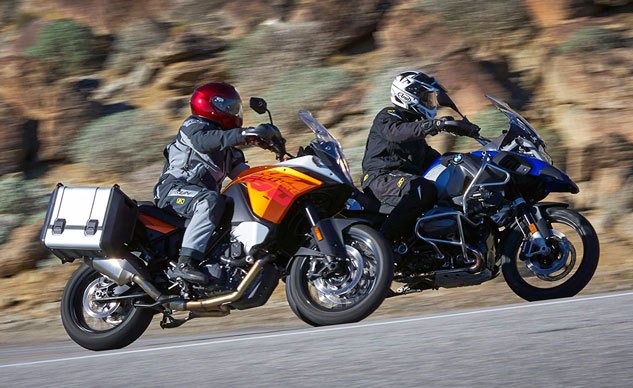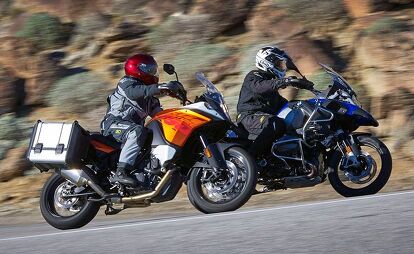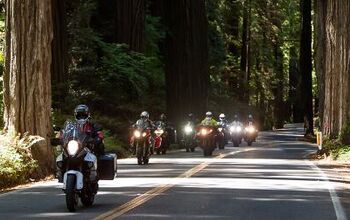Battle Of The Adventures: BMW Vs. KTM + Video
Which is more adventurous?
Instead of two specially-prepped BMW R1150GS Adventures, Ewan McGregor and Charley Boorman should have split Long Way Round riding duties between stock versions of the GSA and KTM’s (at the time) 950 Adventure. An epic shootout of 20,000 around-the-world miles! Alas, they did not. Leaving moto hacks such as myself and John Burns to venture less than twenty-hundred miles within the confines of the state of California. Kind of the opposite of epic.
At least we were aboard BMW’s and KTM’s latest and greatest Adventure models – the BMW R1200GS Adventure and the KTM 1190 Adventure – both equipped with the kind of electronic wizardry Obi-Wan and Boorman could only dreamed of having back in 2004. They were rumored to have three chase vehicles (one of them driven by a BMW mechanic). We had our videographer, Jay McNally, and his Dodge Caravan. Anyway, back to the electronics.
Both Adventures are outfitted with impressive electronic arsenals. ABS and TC are standard on both bikes, are switchable and vary in intrusiveness according to the Riding Mode selected. Such as on the BMW, selecting Enduro Pro mode leaves TC engaged but minimizes its effect, and switches ABS off on the rear wheel while leaving it engaged for the front wheel. KTM’s Off-Road mode allows 100% of rear-wheel slippage, a higher degree of ABS-controlled front-wheel slippage than in Street mode, while ABS and cornering ABS (C-ABS) are disengaged at the rear wheel.
| BMW | KTM | |
| ABS | Standard, switchable, differs by Riding Mode | Standard, switchable, differs by Riding Mode, customizable, C-ABS exclusive |
| Cruise Control | Yes | No |
| ESA | Preload: Solo, Rider with Luggage, Rider and Passenger Damping: Hard, Normal, Soft | Preload: Solo, Solo with luggage, Two-up, Two-up with luggage Damping: Sport, Street and Comfort |
| Heated Grips | Yes | Optional |
| Ride Modes | Rain, Road, Dynamic, Enduro, Enduro Pro | Rain, Street, Sport, Off-Road |
| Traction Control | Standard, Switchable, differs by Riding Mode | Standard, Switchable, differs by Riding Mode |
While the electronics packages are similar, they do differ in their offerings. A glaring omission is the absence of cruise control on the KTM.
You may have noticed we chose to pit BMW’s ultra off-roader against KTM’s standard Adventure, instead of the 1190 Adventure R model. The reasoning behind this decision was mostly tire size uniformity. Both of these Adventures use identically sized tires:120/70-19 fronts and 170/60-17 rears. The R-spec KTM is equipped with a more off-road-worthy 90/90-21 and 150/70-18 front/rear tire-size combo, while the standard GS has cast-aluminum wheels as standard. More important, though, is electronic suspension. When it comes to suspension, BMW and KTM are working on an inverse premise between the two company’s Adventure-Touring models. Where KTM has ESA on its more streetable 1190 Adventure and clicker components on its more off-road R model, BMW has ESA as part of the Premium Package on its Adventure model and non-ESA suspension on the base model Adventure (if you can actually find a base model GSA) and GS.
2013 KTM 1190 Adventure R Review
The e-suspensions are similar in operation. KTM’s provides an extra preload setting (two-up with luggage), but when it comes to compression and rebound, the BMW exhibits a wider range of damping. BMW’s Soft setting is cloud-like compared to its Hard setting, whereas KTM’s Comfort remains relatively stiff.
“Even on Comfort, the KTM’s ride is never quite as plush as the BMW’s,” says Out-To-Lunch Editor, John Burns. “On Soft, the BMW is a porch swing rocking back and forth. On Hard with full bags, tearing up and down Montezuma Grade, it was a transformed beast able to keep the KTM in sight.”
The GS is a dauntingly large bike. With a full tank of fuel (an impressively generous 7.9 gal), it weighs in without the aluminum bags at 603 pounds (add 13 pounds per bag). Seat height in the low setting is 35 inches. You don’t need to be Paul Bunyan, but it helps, even with the $250 Low Suspension option that reduces height by 1.2 inches. The KTM, on the other hand, weighs 81 pounds less with a comparatively low seat height of 33.8 inches, 1.2 inches less than the BMW. The GS carries 1.8 gallons more fuel, but that’s only worth 11 pounds, leaving a 70-pound difference between the two.
2014 BMW R1200GS Adventure Review – First Ride
While the BMW certainly has the extended range for discovering what’s around the bend (300 miles vs 216 miles for the KTM), its extra weight makes righting the bike following a tip-over a daunting task. While the KTM isn’t exactly light, its 70-pounds difference could mean the difference between riding or walking back to civilization.
The combination of lighter weight and more formidable engine gives the KTM performance advantages both on and off the pavement. “As a sportbike, the 80-pound lighter, 19-hp stronger KTM will kill the BMW, but it’s amazing how almost-as-fast the BMW is to the KTM in spite of its spec-chart disadvantage, and how creature-comfortable it is compared to the KTM,” says Burns.
Like suspension settings, BMW has a wider range of Riding Modes with Enduro and Enduro Pro available compared to KTM’s single Off-Road offering. BMW’s Enduro mode softens both suspension as well as throttle response, whereas Enduro Pro stiffens suspension and sharpens throttle response – the differences are obvious when switching between the two. KTM’s Off-Road mode reduces horsepower and TC intervention, allowing more rear-wheel spin, but this is the only off-road setting available.
“The KTM engine will lug right down and pull from 2500 rpm, but it always wants you to open the gas,” says Burns. “The BMW on the other hand, seems like it was bred to be a pack mule, content and happy to poke along slow and find footing… but with a 108-hp top end, that seems like plenty.”
When transitioning or hard braking the GSA exhibits superior chassis stability due to its Telelever front end. With its long-travel suspension and conventional fork, the KTM’s front dives when the front binders are applied, and when the pace gets really hot you can feel the bike moving around, not able to settle. Still, the KTM gets to and through corners quicker than the Beemer, the GSA’s weight and size making it seem somewhat lethargic by comparison.
Stopping power and modulation on either bike is exceptional, as is either bike’s ABS. Admittedly, neither Burns nor I had the wherewithal to test the limits of KTM’s C-ABS. Maybe next time.
Both bikes are equipped with manually adjustable windscreens. Advantage here goes to BMW for not only providing more protection but also for its single twist-knob that provides on-the-fly adjustability. The KTM’s windscreen is proportionate to the bike’s fairing, so its hard to fault the amount of protection (optional, larger screens exist), but its failure is requiring a rider to stop prior to adjusting the screen’s position.
The width of the GS’s fuel tank/fairing also goes a long way in protecting its rider. It’s a mental challenge to wrap your mind around how large the GS appears, especially with those crashbars adding girth, but the tradeoff is excellent lower-body protection from the elements.
When our adventure tour of Southern California and its deserts had concluded, the heavier but less powerful BMW arrived home with a slight advantage in fuel economy: 37.9 mpg, versus 35.5 mpg for KTM.
“Though the KTM seems like it should be really similar to the MOBOTY Super Duke R, it never feels quite as smooth and relaxed as that bike does at cruising speed,” says Burns. “Even on Comfort, its ride is never quite as plush as the SDR or the BMW, and the engine never runs quite as smooth as either of those.”
Engine vibration is something I noted in my First Ride Review of the 1190 Adventure. Giving the KTM a “Sigh” for a very vibey engine above 8000 rpm. “After an extended period of high-rpm canyon riding I grabbed another gear (my ass cheeks were getting tingly) which diminished the worst of the vibrations as well as the illumination of the MTC warning light,” said I.
+ Highs
- Comfort & performance
- Shaft drive
- Suspension more compliant; wider range of electronic damping
– Sighs
- Big, heavy, expensive
- Don’t drop it!
- Lofty seat height
We’re giving the KTM Adventure the performance edge largely for its insurmountable combination of more power and less weight compared to the GSA. However, the press launch for the GSA was a largely off-road affair, and there were journalists of varying off-road skills in attendance. It was a witnessable proving ground for the GSA’s abilities in the hands of talented and less-talented riders. So don’t think the GSA can’t hang in the dirt. It can, albeit with a little more effort.
A vast price difference of more than $5k exists between these two models. BMW does offer the standard model GS for a base price of $16,175. Adding the (stupidly named -Ed.) Standard Package ($1580), which has ESA, cruise control and heated grips, brings the MSRP to $17,755 – $144 less than the KTM without cruise control or heated grips! Although the standard GS remains less powerful and significantly heavier than the KTM, it’s a bike worth serious consideration if you’re shopping for a big adventure-tourer.
+ Highs
- More performance than BMW
- Less: Weight, seat height, price
- Just wait ’til my big brother, the Super Adventure, arrives!
– Sighs
- No cruise control
- Bags not as off-road worthy as BMW
- Engine’s a little vibey, especially for the long haul
After our adventures on these two Adventure models, Burns sums up our experience thusly. “I guess at the end of the day, the KTM is the harder-edged weapon for testosterone-filled competitive younger riders who plan to put in serious off-road mileage aboard the Black Stallion. The BMW’s a more comfortable old saddle horse, less speedy but completely comfortable and predictable. If you actually were going to ride a motorcycle around the world, I think it’s the one you’d pick.”
Battle Of The Adventures Scorecard
| Category | BMW R1200GS Adventure | KTM 1190 Adventure |
|---|---|---|
| Price | 76.6% | 100% |
| Weight | 86.5% | 100% |
| lb/hp | 74.0% | 100% |
| lb/lb-ft | 84.6% | 100% |
| Engine | 90.0% | 91.3% |
| Transmission/Clutch | 82.5% | 82.5% |
| Handling | 85.0% | 87.5% |
| Brakes | 85.0% | 87.5% |
| Suspension | 96.3% | 83.8% |
| Technologies | 96.3% | 80.0% |
| Instruments | 90.0% | 85.0% |
| Ergonomics/Comfort | 96.3% | 86.3% |
| Luggage/Storage | 95.0% | 77.5% |
| Quality, Fit & Finish | 96.3% | 85.0% |
| Cool Factor | 96.3% | 91.3% |
| Grin Factor | 87.5% | 85.0% |
| Overall Score | 89.3% | 88.4% |
Battle Of The Adventures Specs | |||
| BMW R1200GS Adventure | KTM 1190 Adventure | ||
| MSRP | $23,463 | $17,899 | |
| Horsepower | 108.7 hp @ 7800 rpm | 127.4 hp @ 9200 rpm | |
| Torque | 77.6 lb-ft @ 6600 rpm | 79.3 lb-ft @ 7400 rpm | |
| Engine Capacity | 1170cc | 1195cc | |
| Engine Type | Air/liquid-cooled horizontally opposed Twin | Liquid-cooled 75° V-Twin | |
| Bore x Stroke | 101mm x 73mm | 105mm x 69mm | |
| Compression | 12.5:1 | 12.5:1 | |
| Fuel System | EFI | EFI | |
| Transmission | 6-Speed | 6-Speed | |
| Clutch | Hydraulic | Hydraulic | |
| Final Drive | Shaft | Chain | |
| Frame | Steel trellis | Steel trellis | |
| Front Suspension | Electronically adjustable Telelever, 8.3 inches of travel | Electronically adjustable 48mm inverted fork, 7.5 inches of travel | |
| Rear Suspension | Electronically adjustable Paralever, 8.7 inches of travel | Electronically adjustable WP monoshock, 7.5 inches of travel | |
| Front Brakes | Dual 305mm discs, 4-piston radial calipers | Dual 320mm discs, 4-piston Brembo calipers | |
| Rear Brakes | Single 276mm disc, 2-piston caliper | Single 268mm disc, 2-piston Brembo caliper | |
| Front Tire | 120/70-19 | 120/70-19 | |
| Rear Tire | 170/60-17 | 170/60-17 | |
| Seat Height | 35.0/35.8 in | 33.8/34.4 in | |
| Wheelbase | 59.4 in | 61.4 in | |
| Curb Weight (without bags) | 602.7 lbs | 521.6 lbs | |
| Fuel Capacity | 7.9 gal | 6.1 gal | |
| Colors | Alpine White, Olive Green Metallic Matte, Racing Blue Metallic Matte | Grey, Orange | |
A former Motorcycle.com staffer who has gone on to greener pastures, Tom Roderick still can't get the motorcycle bug out of his system. And honestly, we still miss having him around. Tom is now a regular freelance writer and tester for Motorcycle.com when his schedule allows, and his experience, riding ability, writing talent, and quick wit are still a joy to have – even if we don't get to experience it as much as we used to.
More by Tom Roderick






































































































Comments
Join the conversation
Why on earth didn't you compare the STANDARD GSW to the 1190? Same wheel size and tires as the KTM, 50 pounds lighter than the Adventure, and similar suspension travel (the adventure is 1/2 " more). Not to mention 2.5 gallons less at curb weight. Apples and oranges. ..
In KTM-speak, C-ABS stands for Combined ABS. When the front brake is applied some rear is added. Not vice versa though.